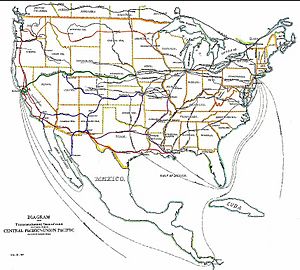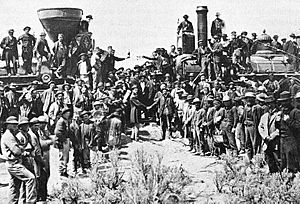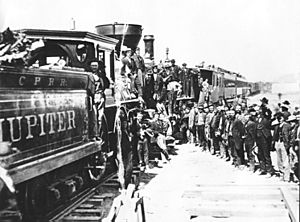Transcontinental Railroad facts for kids
A transcontinental railroad in the United States is a continuous train track that connects the Pacific coast (on the west side) with the eastern part of the country. These eastern railroads usually ran between the Missouri River or Mississippi River and the Atlantic coast. The very first idea for a transcontinental railroad in the U.S. was shared with Congress by Asa Whitney in 1845.
Many transcontinental railroads were built in the late 1800s. They created a huge transportation network across the country. This network connected the United States by rail. The first of these, called the "Pacific Railroad," was about 3,103 km (1,928 mi) long. It was built by two companies: the Central Pacific Railroad and the Union Pacific Railroad. They linked the San Francisco Bay in Alameda, California, with the existing eastern railroad system in Council Bluffs, Iowa/Omaha, Nebraska. When it opened in 1869, it became the world's first transcontinental railroad. The U.S. government helped make its construction possible through the Pacific Railroad Acts of 1862, 1864, and 1867. Its original path was very close to today's Interstate 80 highway.
Contents
What is a Transcontinental Railroad?
The first U.S. First transcontinental railroad was built between 1863 and 1869. Its goal was to join the eastern and western halves of the United States. Work started just before the American Civil War. Building it was seen as one of the greatest American achievements of the 1800s.
Building the First Transcontinental Railroad
When it opened, this railroad was known as the "Pacific Railroad." It became a super important link for trade, business, and travel. It also opened up huge areas of the North American heartland for people to settle. For the first time, shipping and business could grow far away from rivers. Today, much of this route is still used by Amtrak's California Zephyr.
People started building the Transcontinental Railroad in 1863. The Central Pacific Railroad built east from Sacramento, California. The Union Pacific Railroad built west from Omaha, Nebraska. The two railroads met at Promontory Summit, Utah, on May 10, 1869. Many of the workers who built it came to the U.S. from China and Ireland.
How the Railroad Changed America
The transcontinental railroad made travel fast, safe, and cheap. A one-week trip from Omaha to San Francisco cost about $65 for an adult. This new way of travel replaced the much slower and more dangerous stagecoach lines and wagon trains. The number of people taking the Oregon Trail and California Trails dropped a lot. The railroad also helped sell land and transport timber and crops. This led to the quick settlement of the "Great American Desert."
Land for the Railroads
Building the Transcontinental Railroad needed a lot of land. The government had a complex plan for buying and giving out this land.
Key Dates and Connections
- One reason for the Gadsden Purchase of land from Mexico in 1853 was to get good land for a southern transcontinental railroad. The Southern Pacific Railroad was finished in 1881.
- The Pacific Railroad Act of 1862 allowed land to be given for new rail lines. These lines would "aid in the construction of a railroad and telegraph line from the Missouri river to the Pacific ocean."
- The tracks of the "First transcontinental railroad" were joined on May 10, 1869. This happened with a special ceremony where the "Last Spike" was driven at Promontory Summit, Utah. The Union Pacific Railroad and Central Pacific Railroad laid 2,826 km (1,756 mi) of track in six years.
- The first continuous train line from coast to coast was completed 15 months later, on August 15, 1870. This was done by the Kansas Pacific Railroad in Strasburg, Colorado. This route connected to the eastern rail network through the Hannibal Bridge at Kansas City. It went through Denver, Colorado, and north to the Union Pacific Railroad at Cheyenne, Wyoming. This made it possible to travel entirely by train from Jersey City, New Jersey, to the San Francisco Bay in Oakland.
Other Important Transcontinental Routes
After the first one, many other transcontinental railroads were built.
- Almost 12 years after Promontory Summit, the Southern Pacific Railroad (SP) built the second transcontinental railroad. It went east through the Gadsden Purchase land. This line was finished in 1881 and 1883.
- The Northern Pacific Railway (NP) completed the fifth independent transcontinental railroad on August 22, 1883. It linked Chicago with Seattle. A ceremony was held on September 8, 1883, with former U.S. President Ulysses S. Grant helping to drive the Final Spike.
- The Great Northern Railway was built without federal help by James J. Hill in 1893. It stretched from St. Paul to Seattle.
- In 1909, the Chicago, Milwaukee & St. Paul (or Milwaukee Road) finished its Pacific extension to Seattle. It was renamed the Chicago, Milwaukee, St. Paul and Pacific.
- In 1993, Amtrak's Sunset Limited train was extended to Miami, Florida. This made it the first regular transcontinental passenger train route in the U.S. run by one company. Hurricane Katrina damaged this route in 2005. Now, the train runs from Los Angeles to New Orleans.
The Gould System: A Big Dream
George J. Gould tried to create a truly transcontinental railroad system in the 1900s. A line from San Francisco, California, to Toledo, Ohio, was finished in 1909. It used several different railroads, including the Western Pacific Railway, Denver and Rio Grande Railroad, Missouri Pacific Railroad, and Wabash Railroad. Gould had plans to extend it further east, but a financial crisis in 1907 stopped his plans. Today, after many mergers, only the Union Pacific Railroad and the BNSF Railway carry the entire route.
See also
 In Spanish: Ferrocarril transcontinental para niños
In Spanish: Ferrocarril transcontinental para niños




